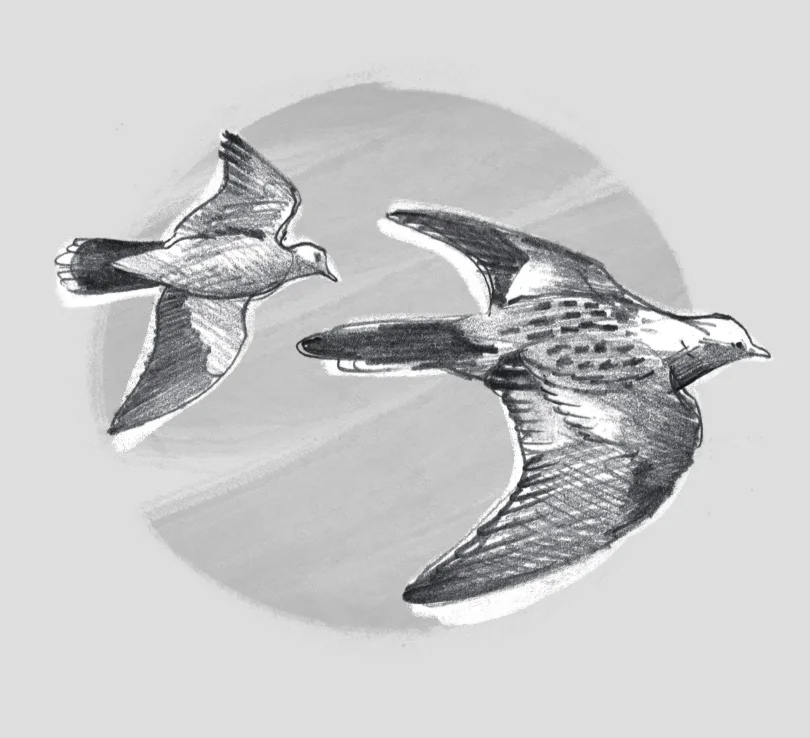A very common bird in all types of woodland below 1000m, in some places can constitute a nuisance. Sings “take two cows taffy…”
COLLARED DOVE (Streptopelia decaocto) -Tourterelle turque
A relatively recent arrival in Europe, found mostly in association with human habitation. Sings “no stew cook”.
TURTLE DOVE (Streptopelia turtur) -Tourterelle des bois
A summer visitor to the lowlands of Switzerland, found in semi-open woodlands, mostly restricted to the north. It has a distinctive rolling song that reminds me of warm summer days.
COMMON CUCKOO (Cuculus canorus) - Coucou gris
Not an uncommon bird which is fairly secretive except for the call which is probably known by everyone.
EURASIAN PYGMY OWL (Glaucidium passerinum) - Chevêchette d’Europe
A rather uncommon bird of forests between 1000-2000 meters. It is a day-time hunter, small and the colouration makes it very hard to see. The call is very distinctive however.
TAWNY OWL (Strix aluco) - Chouette hulotte
A fairly common bird of forests between up to 1500m in Switzerland. Nocturnal habits make it hard to see but most people can recognise this owl’s hoot:
LONG-EARED OWL (Asio otus) Hibou moyen-duc
Long-eared Owls are not a rare species, but neither are they common. But their habits and calls are very subtle and discrete, making them hard to see and their gentle hooting calls are easily overlooked, even though they can carry a surprising distance.
TENGMALM’S OWL (Aegolius funereus) - Chouette de Tengmalm
A fairly uncommon bird of forests between 1000 and 2000m asl in Switzerland. Its calls are a series of rather monotone “poops”.
COMMON SWIFT (Apus apus) - Martinet noir
Present only for a few months in summer Swifts are a common sight over fields and villages often in small flocks screaming their calls from up on high. But those calls contain a hidden secret….
EUROPEAN BEE-EATER (Merops apiaster) - Guêpier d'Europe
A spectacular bird whose localised populations are expanding in Switzerland. Nesting in colonies they catch their insect prey on the wing as the name implies; they give a soft rolling song.
WRYNECK (Jynx torquila) - Torcol fourmilier
A distant member of the woodpecker family. About the size of a thrush, it gets its name from the ability to twist its head around. The call is reminiscent of a Green Woodpecker with sinus problems.
GREY-HEADED WOODPECKER (Picus canus) - Pic cendré
Closely related to the Green Woodpecker, and easily confused with that. The call has a more mournful, and squeaky timbre to it, try it here.
GREEN WOODPECKER (Picus viridis ) - Pic vert
With its red cap, green back and black mask, this bird is a spectacular resident in wooded areas. Its laughing call rings out loud and carries far.
IBERIAN GREEN WOODPECKER- (Picus sharpei)
Very similar to the European Green Woodpecker, but a separate species, learn how to identify by appearance and calls here.
GREAT SPOTTED WOODPECKER (Dendrocopos major) - Pic épeiche
Probably the most common of the woodpeckers in Europe with black and white plumage and a very distinctive “KWICK” call being frequently heard.
MIDDLE SPOTTED WOODPECKER (Dendrocopos medius) - Pic mar
A less common woodpecker, mostly confined to mature oak woods, easily confused with Great Spotted but with a distinctive nasal advertising call which is useful to learn.
LESSER SPOTTED WOODPECKER (Dendrocopos minor) - Pic épeichette
The smallest of the woodpeckers in Europe and easily overlooked, listen out for its high-pitched squeaky call.
BLACK WOODPECKER (Dryocopus martius) Pic Noir
The largest woodpecker in Europe with beautiful contrasting black and red colouration and a series of far-carrying yelping calls.
THREE-TOED WOODPECKER (Picoides tridactylus) Pic tridactyle
A rather discrete woodpecker of sub-alpine forests, not easy to find. It has an interesting way of life, specialising on bark beetles in spruce forests. It has a call very similar to a Great Spotted Woodpeckers and this article explains why, and how to identify the call.
WOODLARK (Lullula arborea) - Alouette lulu
An uncommon species in Switzerland following big declines in the ‘90s - it can be identified through its song which is a beautiful outpouring of liquid tones delivered in flight:



















